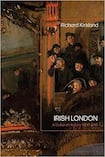
It seems a simple question, but where is the most Irish place outside of Ireland? Boston, New York or Sydney? Or maybe London. For as long as records exist there has been an Irish presence in that city, an everyday reminder to Londoners that “we are here because you were there”, to use the slogan of anti-racist activists.
One consequence of Britain’s colonisation of Ireland is that Irish people could settle in England without any restriction up to and including the present day. And the preference within England has always been to head to London.
The Irish have now finally conquered London – the 639th lord mayor of the City of London is Vincent Keaveny, a lawyer from Dublin.
So this wonderful new book by Richard Kirkland is a very relevant and also timely reminder of Irish London’s heritage. Most of the people whose lives are explored in this account were born and reared in Ireland. The title is important to distinguish the coverage from the London Irish, the group stretching across generations, badly in need of a similar scholarly study.
Irish London opens with a vivid description of the St Giles Rookery, an Irish slum in the West End of London. Described by one contemporary in the 1840s as “a disgrace to a civilised country”, the poverty and crime were emblematic of everything that was seen as wrong and offensive about the poor Irish.
The numbers of Irish arriving in St Giles during the Famine created terror in the minds of stern Protestant evangelicals, as not alone was this a dreadful “Little Ireland”, it was a dreadful (and growing) “Little Catholic Ireland”. Even more disturbing was that the Hibernian residents of St Giles Rookery came into the nearby affluent middle-class areas, marauding in gangs of “street children”.
Fenian campaign
Moral panic and urban property speculation in the 1840s and 1850s put paid to the St Giles Rookery, and the poor Irish spread out across the city, settling in districts such as Clerkenwell, North Kensington and Southwark. Only in the 1950s would Kilburn and Cricklewood emerge as the “Irish” areas of London.
The new wave of interest in the Irish in London occurred during the Fenian dynamite campaign of the 1880s, when the shadowy world of radical republicanism came to London (an earlier attack on Clerkenwell prison to free a Fenian prisoner had killed 12 passers-by in December 1867). Attacks on the Underground and at railway stations injured many people in what was called the “Dynamite War”. Anyone Irish who lived in or visited London during the more recent Troubles will know what this meant: animosity, anti-Irish hostility and the knowledge that this new form of terrorism made the Irish a suspect community.
Kirkland reminds us of an allusion to these events in Oscar Wilde’s The Importance of Being Earnest (1895), which he describes as “perhaps the greatest nineteenth-century Irish London text of all”. Jack Worthing was left by his governess, Miss Prism, in a handbag at the cloakroom of Victoria station. Most of Wilde’s London audience will have recognised that in February 1884 a timed bomb was left in a handbag in the very same location, which exploded in the early hours of the morning when the station was empty.
Wilde’s subtle reference is a nice bridge to what is essentially the core focus of the book: the painters, writers, performers, journalists, revolutionaries and cultural nationalists who made up Irish London between the 1890s and the Easter Rising in 1916. As appropriate for a literary scholar, Kirkland is especially skilful at locating these people within the wider cultural milieu during the Irish Revival.
Forgotten performer
High points include the fascinating account of Bessie Bellwood, a performer now largely forgotten but who was a very popular figure in the London music hall scene in the 1880s and 1890s. She was born to a family from Monkstown, Co Cork, in 1857, raised in Bermondsey, and died tragically young at the age of 39. Her funeral in September 1896 was a huge event, with crowds lining the street to pay their respects as the cortege passed through the city.
Another well-known figure, Michael Collins, spent his early working life in London, at the citadel of Irish republicanism abroad: the British Post Office. In total Collins spent nine years there, from his arrival aged 15 years in 1906 until his return to Ireland in January 1916, to assist in preparations for the Easter Rising. Kirkland is right to point out that his biographers have played too little attention to these years in his formation as the archetypal Irish revolutionary.
Irish London is an important book reminding of us of our deep connections with London well before the great exodus of Irish to the city in the 1940s and 1950s.
Enda Delaney is professor of modern history at the University of Edinburgh











